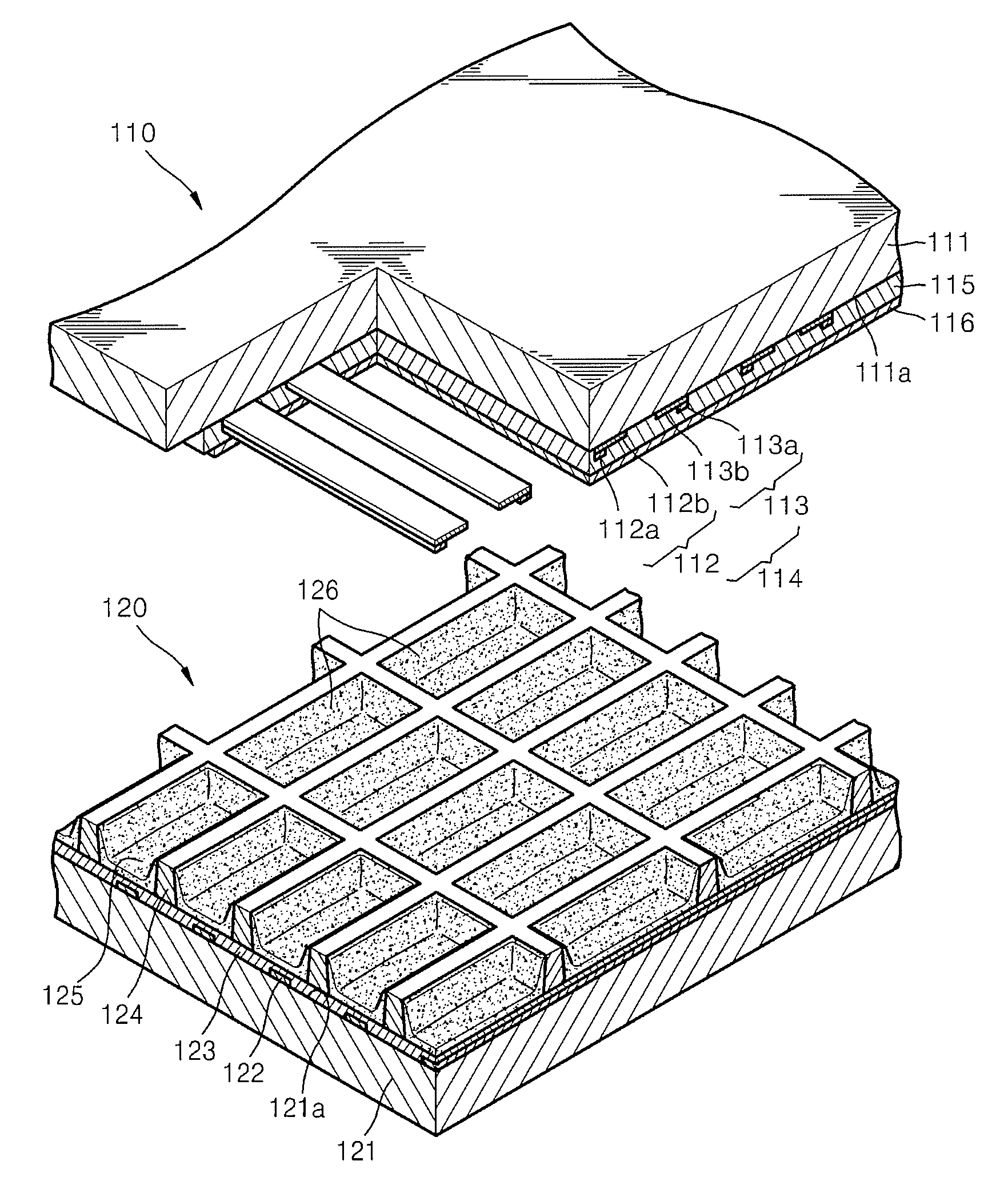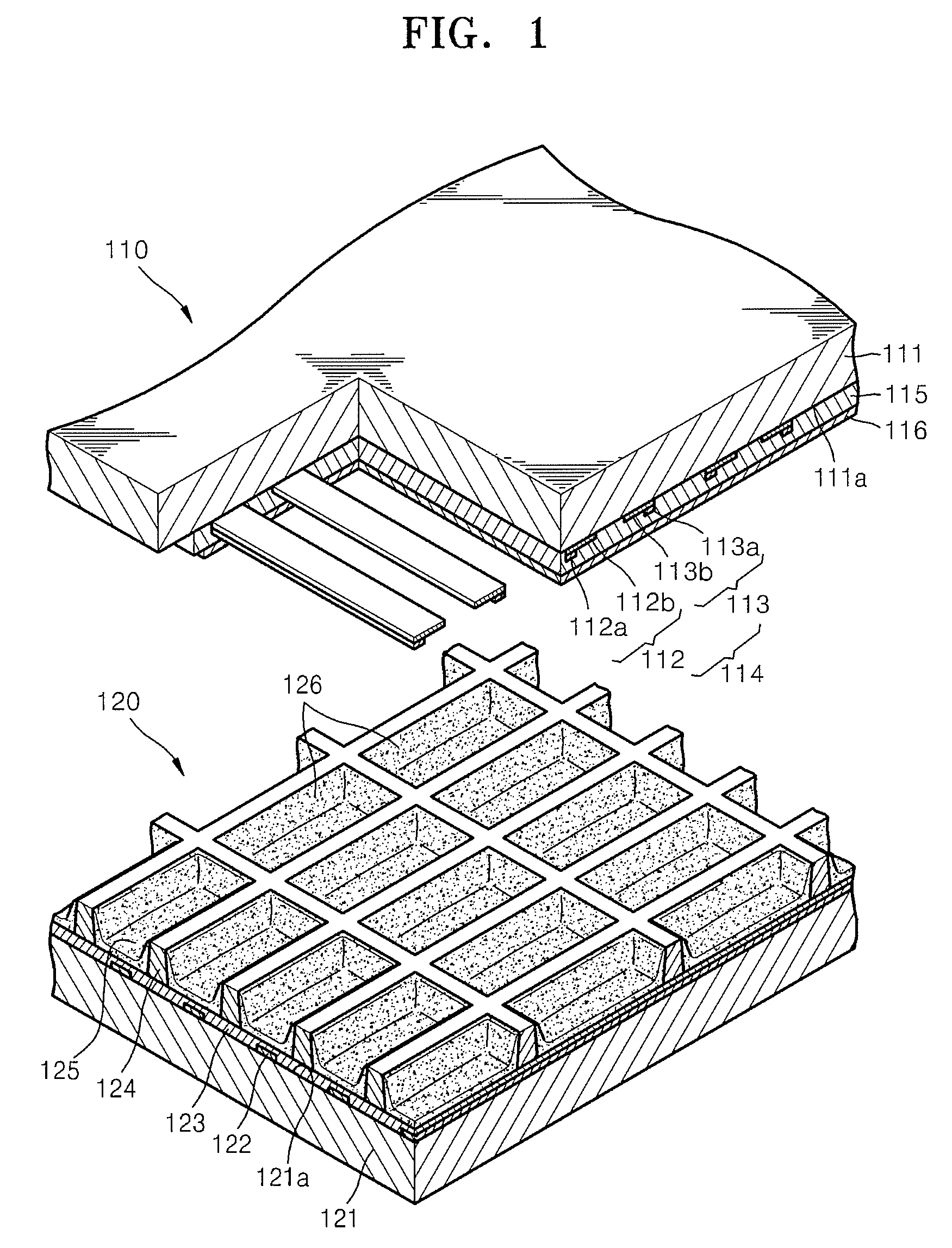Photosensitive paste composition, barrier rib prepared using the composition and plasma display panel comprising the barrier rib
a technology of composition and barrier rib, which is applied in the manufacture of photosensitive materials, electric discharge tubes/lamps, instruments, etc., can solve the problems of time-consuming methods, difficulty in forming uniformly patterned barrier ribs, and complicated sandblasting process, etc., and achieves high resolution, high precision, and high reflective index.
- Summary
- Abstract
- Description
- Claims
- Application Information
AI Technical Summary
Benefits of technology
Problems solved by technology
Method used
Image
Examples
example 1
Preparation of Tantalum Oxide Organic-Inorganic Complex
1-1. Preparation of Tantalum Oxide
[0088]To hydrolyze and condense tantalum (V) ethoxide, 100 ml of n-BuOH and 1.40 g of pure water as a solvent were added to a reactor. While the mixture was stirred, 0.017 mole of HCl was slowly added thereto. After stirring for about 30 minutes, 5.28 g (0.013 mole) of tantalum (V) ethoxide (purity 99.9%) was slowly added to the mixture while the mixture was stirred. Subsequently, the resulting product was hydrolyzed and condensed to prepare tantalum oxide by stirring at room temperature for 24 hours.
1-2. Preparation of Tantalum Oxide Organic-Inorganic Complex
[0089]The tantalum oxide was subjected to a surface modification reaction by the following procedure using 3-(methacryloyloxy)propyltrimethoxysilane (MPTS) as a surface modifier.
[0090]0.323 g of MPTS (0.0013 mole) was added to 50 g of n-BuOH while stirring and mixing. The prepared tantalum oxide was slowly added thereto while the mixture wa...
example 2
Preparation of Titanium Oxide Organic-Inorganic Complex
2-1. Preparation of Titanium Oxide
[0091]50 g (0.176 mole) of Titanium tetraisopropoxide (Ti(OPr)4) was added to a reactor and stirred. While stirred, a mixed solution of 50 g of tetrahydrofuran (THF) and 10 ml of 1N HCl was slowly added thereto. Subsequently, the mixture was hydrolyzed and condensed to prepare a titanium oxide by stirring until it became transparent.
2-2. Preparation of Titanium Oxide Organic-Inorganic Complex
[0092]Triethoxysilane-capped polyarylene ether sulfone (triethoxysilane-capped PSF) was used as a surface modifier of the titanium oxide. Triethoxysilane-capped PSF was prepared through a reaction of (3-isocyanatopropyl)triethoxysilane and amine-end capped PSF.
[0093]The titanium oxide was subjected to a surface modification reaction by the following procedure.
[0094]While the prepared titanium precursor was stirred, 10 g of triethoxysilane-capped PSF (made into a 10 weight % solution by dissolution in dimethy...
example 3
Preparation of Zirconium Oxide Organic-Inorganic Complex
3-1. Preparation of Zirconium Oxide
[0095]50 g (0.153 mole) of zirconium tetra-n-propoxide (Zr(OPr)4) was added to a reactor and stirred. While stirred, a mixed solution of 50 g of THF and 0.87 ml of 10N HCl was slowly added thereto. Subsequently, the mixture was hydrolyzed and condensed to prepare a zirconium oxide by stirring until it became transparent.
3-2. Preparation of Zirconium Oxide Organic-Inorganic Complex
[0096]The triethoxysilane-capped PSF used in Example 2-2 was also used as a surface modifier of the zirconium oxide, and the zirconium oxide was subjected to a surface modification reaction as in Example 2-2 to prepare an organic-inorganic complex of zirconium oxide.
PUM
| Property | Measurement | Unit |
|---|---|---|
| particle diameter | aaaaa | aaaaa |
| refractive index | aaaaa | aaaaa |
| refractive index | aaaaa | aaaaa |
Abstract
Description
Claims
Application Information
 Login to View More
Login to View More - R&D
- Intellectual Property
- Life Sciences
- Materials
- Tech Scout
- Unparalleled Data Quality
- Higher Quality Content
- 60% Fewer Hallucinations
Browse by: Latest US Patents, China's latest patents, Technical Efficacy Thesaurus, Application Domain, Technology Topic, Popular Technical Reports.
© 2025 PatSnap. All rights reserved.Legal|Privacy policy|Modern Slavery Act Transparency Statement|Sitemap|About US| Contact US: help@patsnap.com



